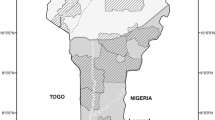Abstract
The choice of plant species, their arrangement and management varies between and within tropical homegardens in the same community. Relationships between agroecological and socioeconomic characteristics of 20 homegardens were examined at Masaya, Nicaragua. Variables analyzed were micro-zonation (area allocation to specific uses and management), plant use and diversity, occupation, labor investment, and product, benefit and income generation. Data was collected through surveys, participatory mapping, plant inventories, direct observation and interviews. Ten different micro-zones and nine plant uses were identified. Fruit trees, shaded coffee and ornamentals were the most important zones. Plant diversity was high, with a sample total of 324 species. Homegardens were an important occupation, with average labor investments of 32.6 h family−1 week−1. Families obtained at least 40 different plant products from homegardens, as well as the benefit of space for working and socializing. Six homegarden types were identified using a cluster analysis based on biophysical variables. Types reflected the relationship between income generation and the number and types of zones and plant species present. Labor inputs were high considering the small size of the homegardens (average size 3,240 m2), although no clear relationships between labor investment and plant and zone type or number were observed. Homegarden management strategies of plant selection and zonation were affected both by family choices and external forces. Although dependence on homegardens may vary according to specific conditions at a given time, they seem to be a consistent, flexible resource used to meet a diversity of needs. The methodological approach used in this paper may be appropriate for the study of other traditional agroecosystems since it includes both biophysical and socioeconomic variables, essential for understanding these complex systems.
Similar content being viewed by others
References
Abdoellah OS (1990) Homegardens in Java and their future development. In: Landauer K and Brazil M (eds) Tropical Home Gardens, pp 69–79. United Nations University Press, Tokyo, Japan
Alvarez-Buylla Roces ME, Lazos Chavero E and García-Barrios JR (1989) Homegardens of a humid tropical region in Southeast Mexico: an example of an agroforestry cropping system in a recently established community. Agroforestry Systems 8: 133–156
Brierley JS (1985) West Indian kitchen gardens: a historical perspective with current insights from Grenada. Food and Nutrition Bulletin 7(3): 52–60.
Brownrigg L (1985) Homegardening in international development: what the literature shows. League for International Food Education, Washington, DC
Budowski G (1990) Home gardens in tropical America: a review. In: Landauer K and Brazil M (eds) Tropical Home Gardens, pp 3–8. United Nations University Press, Tokyo, Japón
Christanty L (1990) Home gardens in tropical Asia, with special reference to Indonesia. In: Landauer K and Brazil M (eds) Tropical Home Gardens, pp 9–20. United Nations University Press, Tokyo, Japan.
Fernandes ECM and Nair PKR (1986) An evaluation of the structure and function of tropical homegardens. Agricultural Systems 21: 279–310
Gliessman SR (1998) Agroecology: Ecological Processes in Sustainable Agriculture. Ann Arbor Press, Chelsea, MI, USA
Hoogerbrugge ID and Fresco LO (1993) Homegarden systems: agricultural characteristics and challenges. Gatekeeper Series No. 39. IIED, London, UK
Jensen M (1993a) Soil conditions, vegetation structure and biomass of a Javanese homegarden. Agroforestry Systems 24: 171–186
Jensen M (1993b) Productivity and nutrient cycling in a Javanese homegarden. Agroforestry Systems 24: 187–201
Jose D and Shanmugaratnam N (1993) Traditional homegardens of Kerala: a sustainable human ecosystem. Agroforestry Systems 24: 203–213
Landauer K and Brazil M (1990a) Introduction & recommendations. In: Landauer K and Brazil M (eds) Tropical Home Gardens, pp vii–ix. United Nations University Press, Tokyo, Japan
Landauer K and Brazil M (eds) (1990b) Tropical Home Gardens. United Nations University Press, Tokyo, Japan
Lok R (ed) (1998a) Huertos caseros tradicionales de America Central: características, beneficios e importancia desde un enfoque multidisciplinario. CATIE, Turrialba, Costa Rica
Lok R (ed) (1998b) Huertos caseros. Módulo de Enseñanza Agroforestal 3. Serie Materiales de Enseñanza 41. Proyecto Agroforestal CATIE/GTZ. Turrialba, Costa Rica
Méndez VE (1996) Influencia de factores socioeconómicos sobre estructuras agroecológicas de huertos caseros en Nicaragua. MSc Thesis, CATIE, Turrialba, Costa Rica
Mergen F (1987) Research opportunities to improve the production of homegardens Agroforestry Systems 5: 57–67
Nair PKR (1993) An Introduction to Agroforestry. pp 85–97. Kluwer Academic Publishers, Dordrecht, The Netherlands
Niñez V (1987) Household gardens: theoretical and policy considerations. Agricultural Systems 23: 167–186
Okigbo BN (1990) Homegardens in tropical Africa. In: Landauer K and Brazil M (eds) Tropical Home Gardens, pp 41–65. United Nations University Press, Tokyo, Japan
Padoch C and De Jong W (1991) The house gardens of Santa Rosa: diversity and variability in an amazonian agricultural system. Economic Botany 45(2): 161–175
SAS Institute (1987) SAS/STAT guide for personal computers: version 6. SAS Institute, Cary, North Carolina, USA
Torquebiau E (1992) Are tropical agroforestry home gardens sustainable? Agriculture, Ecosystems & Environment 41: 189–207
Wojtkowski PA (1993) Toward an understanding of tropical home gardens. Agroforestry Systems 24: 215–222
Author information
Authors and Affiliations
Rights and permissions
About this article
Cite this article
Méndez, V.E., Lok, R. & Somarriba, E. Interdisciplinary analysis of homegardens in Nicaragua: micro- zonation, plant use and socioeconomic importance. Agroforestry Systems 51, 85–96 (2001). https://doi.org/10.1023/A:1010622430223
Issue Date:
DOI: https://doi.org/10.1023/A:1010622430223




